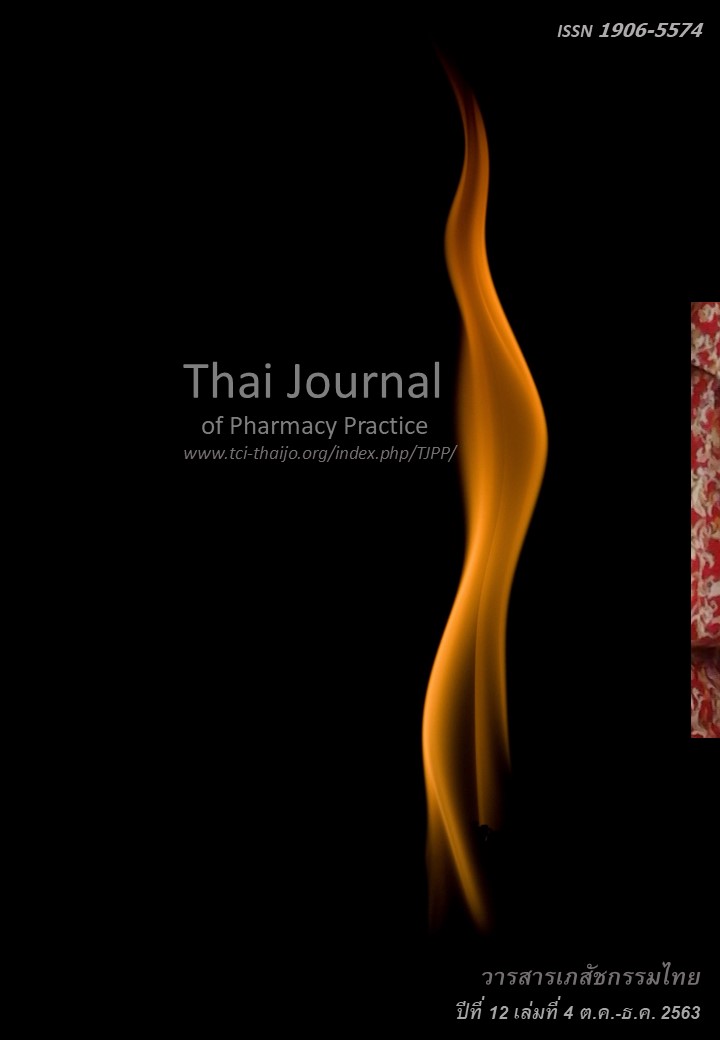การใช้ผลิตภัณฑ์สมุนไพรและผลิตภัณฑ์เสริมอาหารในผู้ป่วยระยะท้ายที่บ้าน: กรณีศึกษาในอำเภอเมือง จังหวัดอุดรธานี
Main Article Content
บทคัดย่อ
วัตถุประสงค์: เพื่อศึกษาชนิด พฤติกรรมการเลือกใช้ ค่าใช้จ่าย และการเกิดอันตรกิริยาจากผลิตภัณฑ์สมุนไพรและผลิตภัณฑ์เสริมอาหาร (herbal products and dietary supplements: HPDS) ต่อยาที่ใช้ของผู้ป่วยระยะท้ายที่บ้าน วิธีการ: การวิจัยนี้เป็นการศึกษาเชิงพรรณนาแบบภาคตัดขวางในช่วงพฤศจิกายน-ธันวาคม 2561 ตัวอย่างคือผู้ป่วยระยะท้าย 70 คนในเขตอำเภอเมือง จังหวัดอุดรธานีทุกราย ผู้วิจัยสัมภาษณ์ตัวอย่างและผู้ดูแลเพื่อเก็บข้อมูลการใช้ HPDS ในผู้ป่วยระยะท้ายที่บ้าน ผลการวิจัย: ผู้ป่วยส่วนใหญ่มีอายุมากกว่า 60 ปี (ร้อยละ 61.4) โรคหลัก 3 อันดับแรกเป็นมะเร็งปอด (ร้อยละ 20.0) มะเร็งท่อน้ำดี (ร้อยละ 17.1) และมะเร็งตับ (ร้อยละ 10.0) ผู้ป่วย 26 คน (ร้อยละ 37.1) ใช้ผลิตภัณฑ์ที่บ้าน 59 รายการ โดยเป็นผลิตภัณฑ์เสริมอาหาร (ร้อยละ 55.2) สมุนไพรตำรับ (ร้อยละ 27.6) และสมุนไพรเดี่ยว (ร้อยละ 17.2) ส่วนใหญ่มีค่าใช้จ่ายไม่เกิน 2,500 บาทต่อเดือน (ร้อยละ 57.7) เหตุผลการเลือกใช้ คือ เพื่อรักษาโรค (ร้อยละ 50.8) และบำรุงร่างกาย (ร้อยละ 44.1) ตัวอย่างร้อยละ 57.6 ใช้ HPDS เพราะได้รับการชักชวนจากลูกหลาน/ญาติ/เพื่อน ผู้ป่วยส่วนใหญ่บริโภคผลิตภัณฑ์วันละ 3 ครั้งพร้อมอาหาร (ร้อยละ 64.4) มีความรู้สึกดีขึ้นและพึงพอใจ (ร้อยละ 88.1) และจะใช้ต่อ (ร้อยละ 86.4) การศึกษาพบผลิตภัณฑ์ที่ไม่เหมาะสมคือ ไม่มีเลขทะเบียน (ร้อยละ 17.0) เสื่อมสภาพ (ร้อยละ 5.1) มีสเตียรอยด์ (ร้อยละ 1.7) และพบอันตรกิริยาต่อยาจาก HPDS (ร้อยละ 20.3) สรุป: ผู้ป่วยระยะท้ายส่วนใหญ่มีการใช้ HPDS เป็นประจำและมีความพึงพอใจต่อการใช้อย่างต่อเนื่อง แต่ยังพบว่ามีการเลือกใช้ไม่เหมาะสมและเกิดอันตรกิริยากับยา ทีมสุขภาพควรให้คำแนะนำต่อการเลือกใช้อย่างเหมาะสมและเฝ้าระวังความปลอดภัยในการใช้
Article Details
ผลการวิจัยและความคิดเห็นที่ปรากฏในบทความถือเป็นความคิดเห็นและอยู่ในความรับผิดชอบของผู้นิพนธ์ มิใช่ความเห็นหรือความรับผิดชอบของกองบรรณาธิการ หรือคณะเภสัชศาสตร์ มหาวิทยาลัยสงขลานครินทร์ ทั้งนี้ไม่รวมความผิดพลาดอันเกิดจากการพิมพ์ บทความที่ได้รับการเผยแพร่โดยวารสารเภสัชกรรมไทยถือเป็นสิทธิ์ของวารสารฯ
เอกสารอ้างอิง
World Health Organization. Worldwide palliative care alliance: Global atlas of palliative care at the end of life. Geneva: WHO; 2014.
Ministry of Public Health, Health Administration Division. Drug system management in palliative care. Nonthaburi: Ministry of Public Health; 2018.
Joint Commission of Pharmacy Practitioners. Patient care process document: Pharmacists’ patient care process [online]. 2014 [cited sep 3, 2018]. Availa- ble from: jcpp.net/patient-care-process.
Hussainy SY, Box M, Scholes S. Piloting the role of a pharmacist in a community palliative care multidisciplinary team: An Australian experience. BMC Palliat Care 2011;10:16. doi: 10.1186/14726 84 X-10-16.
Phanphuwong S, Chanthapasa K. Dietary supple ment consumption behavior of diabetes mellitus patients in tumbon Warischaphum, Warischaphum district, Sakonnakorn province. Isan Journal of Phar maceutical Sciences 2013; 9:155-9.
Sornsuvit C, Phosuya C, Jaroonwanichkul D, Piriya chananusorn N. The use of herbal and dietary supplements and potential interactions with drugs in patients with chronic diseases.Thai Pharmaceu tical and Health Science Journal 2012; 7: 149-54.
Holmes HM, Kaiser K, Jackson S, McPherson LM. Soliciting an herbal medicine and supplement use history at hospice admission. J Palliat Med. 2010; 13:685-94. doi: 10.1089/jpm.2009.0378.
Palliative Care Network Region 8Udonthani. Pallia tive care guideline in Udonthani Hospital. Udon thani: Udonthani Hospital; 2018.


